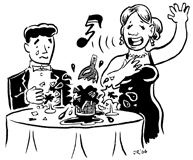Ask an expert: Hitting the high notes
Ask an expert: Hitting the high notes McGill University
User Tools (skip):
ASK AN EXPERT
Hitting the high notes
Q: "Is it really possible for the human voice to shatter glass?"
—Dianne Maloney
Gift/Records Assistant,
Development, Alumni and University Relations

Jack Ruttan
Stephen McAdams, Professor and Canada Research Chair in Music Perception and Cognition; Director, Centre for Interdisciplinary Research in Music Media & Technology, responds:
A: When you clink a glass, you will usually notice that it rings at a certain pitch. The better the quality of the glass, the clearer the pitch. It makes this pitch because it resonates at a particular frequency, that is at the natural rate of vibration of the glass. If a singer sings a pitch at a frequency that is equal to the resonant frequency of the glass, the glass will start to ring by what is called sympathetic vibration. That is, the energy from the acoustic waves leaving the singer's mouth set the glass into vibration because they match. If the singer sings very loudly, the glass may actually shatter because its structure can no longer resist the strong vibrations.
This is also why soldiers are taught to break step when crossing a bridge, because if the frequency of their marching is close enough to the resonant frequency of the bridge, the vibrations may build up to a point at which the bridge will disintegrate.

